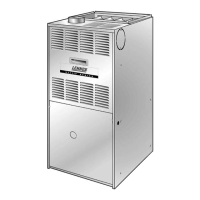Page 14
506176−01 01/2010
See figure 14. Use the provided wire tie to bundle the pres-
sure switch wires with the inducer motor power leads.
Route the wires away from moving parts and the heat
of the inducer motor to prevent damage to the wires.
FIGURE 14
Combustion Air Inducer
(Upflow Position)
Mounting Screws
MOUNTING SCREWS
90°
90°
(Remove)
(Remove)
Flue Transition
(Do not remove)
Flue Outlet
Hole
(Reattach
Cutout Here)
Supply Air
Opening
Top View of Furnace
Top Cap
Cut out
Optional
Flue Outlet
Optional Flue Outlet
(Horizontal Installation)
FIGURE 15
Use sheet metal shears to remove the cut out from the side
of the cabinet. Use the two provided sheet metal screws to
install the cut out on the top cap to cover the original flue
outlet opening. See figure 15.
The G60UH(X) series units are classified as fan−assisted
Category I furnaces when vertically vented according to
the latest edition of National Fuel Gas Code
(ANSI-Z223.1/NFPA 54) in the USA and the current stan-
dards of CSA B149 Natural Gas and Propane Installation
Codes in Canada. A fan−assisted Category I furnace is an
appliance equipped with an integral mechanical means to
either draw or force combustion products through the com-
bustion chamber and/or heat exchanger.
NOTE − Use these instructions as a guide. They do not su-
persede local codes. This furnace must be vented accord-
ing to all local codes these installation instructions, and the
provided venting tables in these instructions
The venting tables in this manual were extracted from the
National Fuel Gas Code (ANSI-Z223.1/NFPA 54) and are
provided as a guide for proper vent installation. Proper ap-
plication, termination, construction and location of vents
must conform to local codes having jurisdiction. In the ab-
sence of local codes, the NFGC serves as the defining doc-
ument.
Refer to the tables and the venting information contained in
these instructions to properly size and install the venting
system.
IMPORTANT
Once the venting system is installed, attach the Dis-
connected Vent" warning sticker to a visible area of
the plenum near the vent pipe. The warning sticker
is provided in the bag assembly.
WARNING
Asphyxiation hazard. The exhaust vent for this fur-
nace must be securely connected to the furnace flue
transition at all times.
FLUE
TRANSITION
COLLAR
VENT CONNECTION
VENT
PIPE
FURNACE
FIGURE 16
Use self−drilling sheet metal screws or a mechanical fas-
tener to firmly secure the vent pipe to the round collar of the
flue transition. If self−drilling screws are used to attach the
vent pipe, it is recommended that three be used. Drive one
self−drilling screw through the front and one through each
side of the vent pipe and collar. See figure 16.
Install the first vent connector elbow at a minimum of six
inches (152 mm) from the furnace vent outlet.

